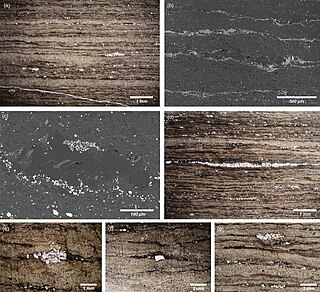
Conodonts are an extinct group of agnathan (jawless) vertebrates resembling eels, classified in the class Conodonta. For many years, they were known only from their tooth-like oral elements found in isolation and now called conodont elements. Knowledge about soft tissues remains limited. They existed in the world's oceans for over 300 million years, from the Cambrian to the beginning of the Jurassic. Conodont elements are widely used as index fossils, fossils used to define and identify geological periods. The animals are also called Conodontophora to avoid ambiguity.

Agnatha is an infraphylum of jawless fish in the phylum Chordata, subphylum Vertebrata, consisting of both present (cyclostomes) and extinct species. Among recent animals, cyclostomes are sister to all vertebrates with jaws, known as gnathostomes.

Promissum is an extinct genus of conodonts, primitive chordates, that lived during the Upper Ordovician period.

Hindeodus is an extinct genus of conodonts in the family Anchignathodontidae. The generic name Hindeodus is a tribute to George Jennings Hinde, a British geologist and paleontologist from the 1800s and early 1900s. The suffix -odus typically describe's the animal's teeth, essentially making Hindeodus mean Hinde-teeth.

Philip Conrad James Donoghue FRS is a British palaeontologist and Professor of Palaeobiology at the University of Bristol.
Richard John Aldridge was a British palaeontologist and academic, who was Bennett Professor of Geology at the University of Leicester.

The palaeoscolecids are a group of extinct ecdysozoan worms resembling armoured priapulids. They are known from the Lower Cambrian to the late Silurian; they are mainly found as disarticulated sclerites, but are also preserved in many of the Cambrian lagerstätten. They take their name from the typifying genus Palaeoscolex. Other genera include Cricocosmia from the Lower Cambrian Chengjiang biota.

Archeognathus is a fossilized jaw apparatus of a large predatory conodont from the Ordovician period. Its large size has made classification difficult, and it has historically been compared to conodonts and gnathostomes since its remains were first discovered in Missouri. Complete articulated jaw apparatus of Archeognathus primus are common in the Winneshiek Shale lagerstätte of Iowa, allowing its identity as a conodont to be secured.

The Soom Shale is a member of the Late Ordovician (Hirnantian) Cederberg Formation in South Africa, renowned for its remarkable preservation of soft-tissue in fossil material. Deposited in still waters, the unit lacks bioturbation, perhaps indicating anoxic conditions.

Paleontology or palaeontology is the study of prehistoric life forms on Earth through the examination of plant and animal fossils. This includes the study of body fossils, tracks (ichnites), burrows, cast-off parts, fossilised feces (coprolites), palynomorphs and chemical residues. Because humans have encountered fossils for millennia, paleontology has a long history both before and after becoming formalized as a science. This article records significant discoveries and events related to paleontology that occurred or were published in the year 2013.

The evolution of fish began about 530 million years ago during the Cambrian explosion. It was during this time that the early chordates developed the skull and the vertebral column, leading to the first craniates and vertebrates. The first fish lineages belong to the Agnatha, or jawless fish. Early examples include Haikouichthys. During the late Cambrian, eel-like jawless fish called the conodonts, and small mostly armoured fish known as ostracoderms, first appeared. Most jawless fish are now extinct; but the extant lampreys may approximate ancient pre-jawed fish. Lampreys belong to the Cyclostomata, which includes the extant hagfish, and this group may have split early on from other agnathans.
Westergaardodina is a species-rich genus of spine, U or W-shaped paraconodont known from Middle Cambrian to Lower Ordovician strata.
Ozarkodinida is an extinct conodont order. It is part of the clade Prioniodontida, also known as the "complex conodonts".
Palmatolepidae is an extinct conodont family. It is part of the clade Prioniodontida, also known as the "complex conodonts".
Notiodella is an extinct conodont genus in the family Balognathidae. It has been described from a 17-element apparatus from the Soom Shale Lagerstätte in South Africa.
Paracordylodus is an extinct genus of conodonts in the clade Prioniodontida, also known as the "complex conodonts". The species P. gracilis has been recovered from the chert of the Narooma Terrane, a geological structural region on the south coast of New South Wales, Australia.

Rossodus is an extinct genus of conodonts in the clade Prioniodontida, the "complex conodonts", of the Early Ordovician.

The conodont feeding apparatus is a series of phosphatic-mineralized elements, resembling a set of “teeth”, which are found lining the oral surface of the conodont animal.
The Waukesha Biota refers to the biotic assemblage of the Konservat-Lagerstätte of Early Silurian age within the Brandon Bridge Formation in Waukesha County and Franklin, Milwaukee County, Wisconsin. It is known for the exceptional preservation of its diverse, soft-bodied and lightly skeletonized taxa, including many major taxa found nowhere else in strata of similar age. The sites discovery was announced in 1985, thus leading to a wide plethora of discoveries being made.

The Winneshiek Shale is a Middle Ordovician (Darriwilian-age) geological formation in Iowa. The formation is restricted to the Decorah crater, an impact crater near Decorah, Iowa. Despite only being discovered in 2005, the Winneshiek Shale is already renowned for the exceptional preservation of its fossils. The shale preserves a unique ecosystem, the Winneshiek biota, which is among the most remarkable Ordovician lagerstätten in the United States. Fossils include the oldest known eurypterid, Pentecopterus, as well as giant conodonts such as Iowagnathus and Archeognathus.












